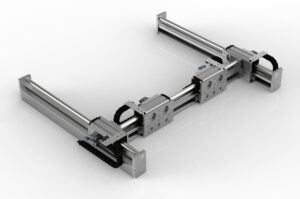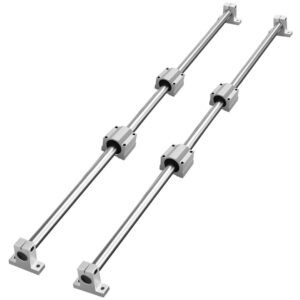Outline for the Article on “Linear Roller Bearings”
| Main Topic | Sub-Topics |
|---|---|
| Introduction to Linear Roller Bearings | What are linear roller bearings?, Historical evolution, Why they matter in precision industries |
| Fundamentals of Linear Roller Bearings | Core components, How they function, Rolling contact principle |
| Types of Linear Roller Bearings | Cylindrical roller bearings, Needle roller bearings, Crossed roller bearings, Custom hybrid bearings |
| Materials Used in Linear Roller Bearings | Steel alloys, Stainless steel, Polymer composites, Ceramic rollers |
| Linear Roller Bearings vs Ball Bearings | Key differences, Advantages of rollers, When to use each |
| Applications of Linear Roller Bearings | CNC machines, Automation systems, Aerospace, Robotics, Heavy machinery |
| Benefits of Linear Roller Bearings | High load capacity, Reduced friction, Long lifespan, Accuracy and rigidity |
| Limitations of Linear Roller Bearings | Cost, Maintenance needs, Environmental sensitivity |
| Installation Guidelines | Preparation, Step-by-step installation, Common mistakes to avoid |
| Maintenance and Care | Lubrication practices, Cleaning techniques, Preventing misalignment |
| Innovations in Linear Roller Bearing Design | Smart sensors, Advanced coatings, Lightweight designs |
| Choosing the Right Linear Roller Bearing | Load and speed considerations, Precision needs, Budgeting |
| Troubleshooting Issues | Excessive noise, Friction build-up, Misalignment, Vibration problems |
| Linear Roller Bearings in Robotics | Role in automation, Load-bearing precision, Enhancing repeatability |
| Linear Roller Bearings in Aerospace | High precision requirements, Lightweight materials, Extreme environment tolerance |
| Linear Roller Bearings for DIY and Makers | Applications in small-scale machines, 3D printers, and automation projects |
| Cost Factors in Linear Roller Bearings | Industrial pricing, Affordable options, Cost optimization |
| Environmental Impact | Recycling, Sustainable materials, Eco-friendly lubricants |
| Future of Linear Roller Bearings | Magnetic levitation, AI-driven monitoring, Predictive maintenance |
| Case Studies | Success in automotive, Innovations in healthcare, Aerospace achievements |
| Standards and Certifications | ISO compliance, Safety considerations, Industry benchmarks |
| Frequently Asked Questions | Addressing common concerns |
| Conclusion | Key takeaways, Future outlook |
| Suggested Inbound & Outbound Links | Internal and external linking strategy |
Introduction to Linear Roller Bearings
A linear roller bearing is one of the most vital motion components in modern engineering. Designed to provide smooth, accurate, and reliable linear motion, these bearings are found in industries ranging from aerospace and robotics to heavy machinery and medical devices. Unlike traditional sliding systems, which rely on surface-to-surface contact, linear roller bearings use rolling elements—specifically rollers—to minimize friction while carrying significant loads.
The concept of roller-based motion dates back centuries, with early engineers using wooden rollers to move massive stones or structures. Over time, this primitive idea evolved into highly engineered systems made of steel, ceramics, and polymers, capable of handling extreme loads with microscopic precision. Today, they represent one of the cornerstones of industrial automation and advanced machinery.
Linear roller bearings matter because they combine strength, precision, and longevity. Their ability to manage heavy loads while ensuring minimal friction makes them indispensable in CNC machines, aerospace navigation systems, and robotic automation. Simply put, without them, many modern industries would struggle to achieve their current levels of accuracy and efficiency.
Fundamentals of Linear Roller Bearings
At its core, a linear roller bearing is designed to provide linear motion with minimal friction while supporting heavy loads. Unlike plain sliding systems, which rely on surfaces sliding against each other, linear roller bearings use rolling elements in the form of cylindrical rollers. This rolling contact drastically reduces resistance, allowing for smoother movement and longer service life.
Core Components of Linear Roller Bearings
Rollers: Cylindrical elements that carry the load and roll along the raceway.
Raceways: Precision-ground tracks that guide the rollers and ensure smooth motion.
Carriage or Housing: The block that holds the rollers in place and interfaces with guide rails.
Seals and End Caps: Components that prevent contamination and retain lubrication.
How They Function
Linear roller bearings operate on the principle of rolling motion. As the bearing moves along its rail, rollers rotate instead of sliding. This reduces the coefficient of friction from around 0.1–0.2 (in sliding systems) to as low as 0.001–0.003. The result is less heat generation, reduced energy consumption, and higher efficiency.
Rolling Contact Principle
The advantage of rollers over balls is the increased contact area. Instead of point contact (as in ball bearings), rollers provide line contact, distributing loads more evenly. This allows linear roller bearings to handle much higher loads while maintaining rigidity and precision.
Whether used in heavy-duty industrial machines or high-precision robotic systems, the fundamentals of linear roller bearings remain the same: smooth, durable, and reliable linear motion.
Types of Linear Roller Bearings
Not all linear roller bearings are created equal. Different types exist to address different engineering challenges, ranging from load capacity to precision and environmental conditions.
Cylindrical Roller Bearings
These are the most common type, featuring straight cylindrical rollers that allow for high load capacity and stiffness. They are widely used in industrial automation and heavy machinery.
Needle Roller Bearings
Smaller in diameter but longer in length, needle rollers provide high load-carrying capacity in compact spaces. They are often found in applications where space is limited but precision cannot be compromised.
Crossed Roller Bearings
In this design, rollers are arranged in alternating perpendicular orientations (crossed), enabling the bearing to handle loads from multiple directions—radial, axial, and moment loads. These are used in robotics and aerospace for applications requiring extreme accuracy.
Custom Hybrid Bearings
Some advanced applications require hybrid designs that combine rollers with other elements like ceramic or polymer components. These are designed for specialized use cases such as cleanroom environments or ultra-lightweight aerospace systems.
Each type has its unique strengths, and engineers must select the one that aligns best with their operational requirements. For example, a CNC machine that needs rigidity and precision may use crossed roller bearings, while a compact automation system might prefer needle rollers.
Materials Used in Linear Roller Bearings
The performance of a linear roller bearing is deeply influenced by the materials used in its construction. Different materials cater to different industrial requirements, whether it’s corrosion resistance, load handling, or weight reduction.
Steel Alloys
Hardened steel is the standard material for most linear roller bearings. It offers excellent strength, durability, and wear resistance. These bearings are common in heavy-duty machines where high rigidity is required.
Stainless Steel
For applications in harsh or corrosive environments, stainless steel is preferred. It resists rust and chemical exposure, making it ideal for food processing equipment, marine systems, and medical devices.
Polymer Composites
In applications where noise reduction and self-lubrication are priorities, polymers are increasingly used. While they may not handle the same loads as steel, they are lightweight, quiet, and maintenance-friendly.
Ceramic Rollers
Ceramic materials, particularly silicon nitride, are used in high-performance linear roller bearings. They are lighter, harder, and more resistant to heat than steel, making them suitable for aerospace and high-speed robotics.
By carefully selecting materials, manufacturers can balance cost, performance, and longevity. A food-grade machine might prioritize stainless steel and polymers, while an aerospace project might lean toward hybrid ceramic-steel bearings.
Linear Roller Bearings vs Ball Bearings
While both systems serve the same purpose—facilitating smooth linear motion—there are distinct differences between linear roller bearings and ball bearings.
Key Differences
Contact Surface: Ball bearings rely on point contact, whereas roller bearings use line contact, allowing them to carry higher loads.
Rigidity: Roller bearings are stiffer due to greater surface contact, making them better suited for applications requiring high precision.
Friction: Ball bearings typically have slightly lower friction than roller bearings at very high speeds.
Durability: Roller bearings handle shock and vibration better, while ball bearings are more vulnerable to impact.
Advantages of Linear Roller Bearings
Superior load-bearing capacity
Greater resistance to deformation
Enhanced rigidity and stability
When to Use Each
Use ball bearings in applications where speed and efficiency matter more than load (e.g., small 3D printers).
Use roller bearings when accuracy, rigidity, and heavy loads are critical (e.g., CNC machining centers, aerospace).
This distinction ensures that engineers select the correct bearing type to maximize both performance and cost-effectiveness.




